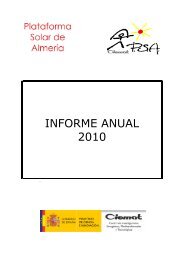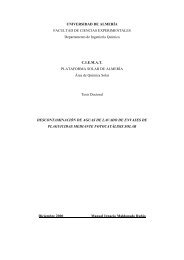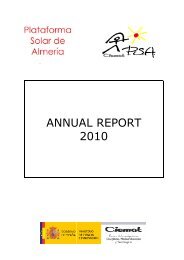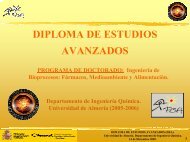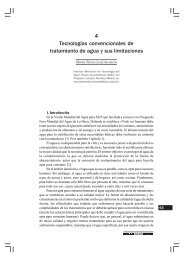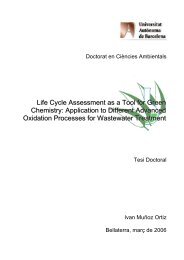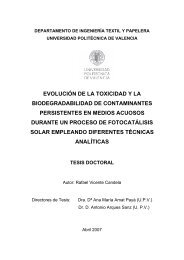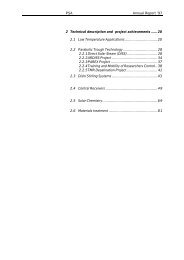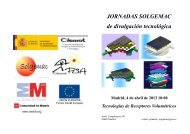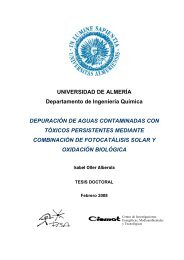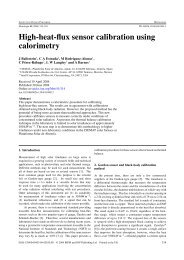Annual Report 2006 - Plataforma Solar de AlmerÃa
Annual Report 2006 - Plataforma Solar de AlmerÃa
Annual Report 2006 - Plataforma Solar de AlmerÃa
Create successful ePaper yourself
Turn your PDF publications into a flip-book with our unique Google optimized e-Paper software.
CONCENTRATING SOLAR SYSTEMS UNIT<br />
Economy (IPHE). The application of the solar concentrating technologies to<br />
high-temperature industrial processes is another field of enormous importance,<br />
which at the PSA is channeled through the SOLARPRO project.<br />
3.4.1 Hydrogen Production<br />
Like its European, American and Japanese counterparts, the CIEMAT, as a<br />
national energy research laboratory, is promoting its own hydrogen technology<br />
<strong>de</strong>velopment program. The weight and goals of the hydrogen production<br />
part of this program are impressive. In spite of all the uncertainties and challenges<br />
posed by the so-called hydrogen economy, it is evi<strong>de</strong>nt that public<br />
R&D programs are going to give more and more significant support to hydrogen.<br />
The main CIEMAT goal in this field is research and <strong>de</strong>velopment of efficient,<br />
competitive hydrogen production methods using authochtonous energy<br />
sources, leading to the implantation of the hydrogen economy in Spain, in<br />
both transportation and stationary consumption. The PSA is the basic instrument<br />
for <strong>de</strong>veloping hydrogen production processes using the abundant solar<br />
resource available in our country and the excellent knowledge of solar concentrating<br />
technologies applicable to reactors operating at temperatures over<br />
1,000ºC. Activity is concentrated in two lines of action (Figure 3.21).<br />
• Development of fossil fuel <strong>de</strong>carbonization processes and technologies<br />
giving them ad<strong>de</strong>d value by solar gaisification, with special attention to<br />
low-quality carbonacious materials.<br />
• Pre-commercial <strong>de</strong>monstration of the technical and economic feasibility<br />
of water-splitting for hydrogen production in thermochemical cycles<br />
with concentrated solar energy.<br />
These lines of R&D are complemented by participation in international forums<br />
and work groups, feasibility studies and roadmaps such as INNOHYP<br />
Roadmap for thermochemical hydrogen production (INNO-<br />
HYP Project: Innovative High Temperature Routes for Hydrogen<br />
Production)<br />
Participants: CEA (F) coordinator, CIEMAT (E), Empresarios Agrupados (E),<br />
ENEA (I), DLR (D), Univ. Sheffield (UK), JRC-Petten (UE), CSIRO (Australia).<br />
Contact:<br />
François Le Naour, francois.le-naour@cea.fr<br />
PSA Contact: Manuel Romero, manuel.romero@ciemat.es<br />
Funding:<br />
Proyecto cofinanciado por la CE. Presupuesto total: 617 k€. Presupuesto<br />
CIEMAT: 55 k€.<br />
Duration: September 1, 2004 – December 31, <strong>2006</strong><br />
Motivation: The accelerated <strong>de</strong>velopment of the so-called hydrogen economy<br />
must unavoidably be through innovative technologies for its mass production<br />
without contaminating emissions and at competitive prices. The use of themrochemical<br />
cycles that achieve thermal <strong>de</strong>composition of the water molecule<br />
in consecutive redox stages is extraordinarily attractive, but requires the use<br />
of a clean, inexhaustible energy source, such as solar energy. The number of<br />
thermochemical cycles analyzed in the literature is enormous, but most of the<br />
options have only been studied theoretically or at the most at laboratory<br />
scale. The interest in a roadmap is to compile the information available on the<br />
various processes and propose joint master lines of action in the European<br />
arena.<br />
55



